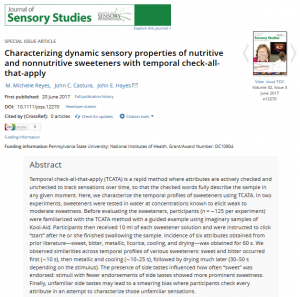Characterizing dynamic sensory properties of nonnutritive sweeteners with temporal check-all-that-apply (TCATA)
 Temporal check-all-that-apply (TCATA) is a rapid method where attributes are actively checked and unchecked to track sensations over time, so that the checked words fully describe the sample in any given moment. Here, we characterize the temporal profiles of sweeteners using TCATA. In two experiments, sweeteners were tested in water at concentrations known to elicit weak to moderate sweetness.
Temporal check-all-that-apply (TCATA) is a rapid method where attributes are actively checked and unchecked to track sensations over time, so that the checked words fully describe the sample in any given moment. Here, we characterize the temporal profiles of sweeteners using TCATA. In two experiments, sweeteners were tested in water at concentrations known to elicit weak to moderate sweetness.
Before evaluating the sweeteners, participants (n = ∼125 per experiment) were familiarized with the TCATA method with a guided example using imaginary samples of Kool-Aid. Participants then received 10 ml of each sweetener solution and were instructed to click “start” after he or she finished swallowing the sample. Incidence of six attributes obtained from prior literature—sweet, bitter, metallic, licorice, cooling, and drying—was obtained for 60 s. We observed similarities across temporal profiles of various sweeteners: sweet and bitter occurred first (∼10 s), then metallic and cooling (∼10–25 s), followed by drying much later (30–50 s depending on the stimulus). The presence of side tastes influenced how often “sweet” was endorsed: stimuli with fewer endorsements of side tastes showed more prominent sweetness. Finally, unfamiliar side tastes may lead to a smearing bias where participants check every attribute in an attempt to characterize those unfamiliar sensations.
![]()
Reyes, M. M., Castura, J. C., & Hayes, J. E. (2017). Characterizing dynamic sensory properties of nonnutritive sweeteners with temporal check-all-that-apply (TCATA). Journal of Sensory Studies, 32, e12270.